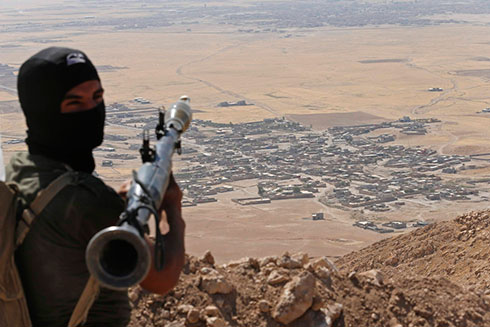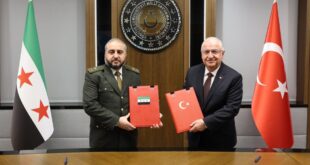The recent attack by the Islamic State, which left dozens of regime soldiers dead, has shown the strength of the Islamic State and reaffirmed the need to confront them militarily writes Syria TV.
The Islamic State (ISIS) has returned in force to the Syrian scene through a series of operations targeting all parties in the Syrian Badia and east of the Euphrates. The most recent operation took place last Wednesday, in the Badia, between the countryside of Deir ez-Zor and Homs, and was the culmination of the operations that had begun to escalate gradually since the middle of last year.
The result of the operation came as a heavy burden on the Syrian regime, which canceled the New Year’s celebrations on state television, in solidarity with the families of the victims, some of whom denounced the regime’s negligence in providing security to soldiers going on vacation. The ISIS statement, in which it claimed responsibility for the operation, stated that the death toll reached 40 among the soldiers belonging to the Fourth Division led by Maher al-Assad, which is taking part in Iranian militia operations in the eastern Euphrates region, especially in Abu Kamal, which has turned into an Iranian base called the Imam Ali Base, and is controlled by the Afghan Fatemiyoun militia and the Iraqi Popular Mobilization Forces (PMF) under the supervision of the Iranian Revolutionary Guard.
Several observations can be made about the operations carried out by ISIS. The first is that they extend over a wide geographical area stretching from Hassakeh Governorate, and including Deir ez-Zor and Raqqa governorates in the direction of the Badia.
The second observation is that these operations have been targeting all the parties controlling this geography on an almost daily basis. Security and military leaders from the Syrian Democratic Forces (SDF), the Russians, the regime, and the Iranian militias fell as a result of them. Perhaps the most prominent of the dead was the Russian Maj. Gen. Vyacheslav Gladkikh, who was killed along with a leader of the National Defense Militia, on Aug. 18, 2020, as a result of an explosive device in the countryside of Deir ez-Zor Governorate.
The third observation is that the operations are gradually escalating and their scope is expanding, intensifying remarkably as of late, despite the military counter-reinforcements.
As for the fourth observation, there has been a clear failure to stop or limit these operations, and this failure is the responsibility of the parties on the ground in these areas, namely Russia, the regime, SDF, and the Iranian militias.
It is known that, last summer, Russia announced a massive military campaign, under the name of the White Desert, with the aim of eliminating ISIS cells in the Badia, which led to the liquidation of 327 militants and the destruction of 134 shelters, 17 observation points, seven stores of ammunition, and five underground stores of weapons and ammunition, according to the official Russian statement about the outcome of the operation.
Experts from the region, where the operations are taking place, chalked up the escalation of ISIS activity to several reasons. The first is the full control of the SDF over the region, except for the Badia which is controlled by the regime and Russia. Undoubtedly, the SDF’s political project in the region meets a general rejection from the Arab majority, especially in the governorates of Deir ez-Zor and Raqqa, which have a 95 percent Arab majority. Since ISIS was eliminated, the two cities fell under the rule of the SDF, which has generated popular resentment fueled by accusations of discrimination, the seizing of wealth from the people of the region, as well as imposing academic curricula by the Kurdish Autonomous Administration.
The second reason is the Iranian militia’s control over large areas in the Deir ez-Zor countryside, bordering Iraq, and their practices against the people of the region, including the widespread Shiite campaigns that have been met with popular opposition by many.
Defeating ISIS would require a different kind of project; one that is based on addressing the major pain points that are due to the practices of the controlling parties.
The third reason is Russian attempts at rehabilitating the regime in the region, within the framework of the policy pursued by Moscow in all areas that it has controlled since its military intervention in September 2015. Those attempts have proven completely unsuccessful, as is the case in the south, where Russia has not even been able to, until this very day, to implement the 2018 agreements. As a result, the region is witnessing a state of total rejection of the regime as well as security chaos, despite Russia’s establishment of military formations, such as the Fifth Corps, which it is working to deploy in Deir ez-Zor.
Defeating ISIS requires handing over the administration of the region to its people and confronting ISIS militarily.
An important observation must be made, which is that ISIS is not popular in the region or with the population. However, no one in the region finds themselves interested in confronting ISIS, knowing that it would probably be in the interest of Russia, the regime and Iran.
 Eurasia Press & News
Eurasia Press & News




